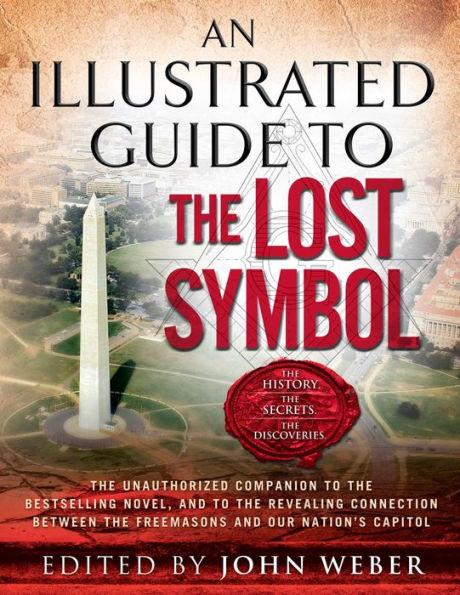An Illustrated Guide to The Lost Symbol
Rich in world history and political power, veiled in secrecy, and rife with rituals and arcane symbols -- from art and architecture to the images that adorn our currency -- the Freemasons arose from ambiguous origins centuries ago to play a major role in drafting the initial documents of the United States, and even in constructing the intricate landscape of Washington, D.C., itself a virtual mystery by design. These puzzles lay the foundation for Dan Brown's serpentine thriller, The Lost Symbol, and also raise provocative questions. Why do some Masonic symbols remain obscured, while others are hidden in plain sight? Which presidents were the embodiments of Masonic ideals? What is the significance of the construction of the Library of Congress, Washington National Cathedral, the Washington Monument, the Capitol, and the physical layout of Washington, D.C.'s roadways and cul-de-sacs? And to what secretive end do they all lead?
Now millions of curious fans can follow Robert Langdon step-by-step, and discover for themselves the answers to the absorbing conundrums posed by The Lost Symbol in this comprehensive, fully illustrated, and intricately detailed tour of the arcana of Washington, D.C. It takes readers through the enigmatic codes, captivating trivia, unfathomable riddles, intriguing records, historic maps, ciphers, and conspiracies of the phenomenal bestseller. What's more, it reveals the fascinating details of a world of unknown locales, mysticism, intrigue, and secret societies -- all of which lie in the shadow of The Lost Symbol.
1100364386
Now millions of curious fans can follow Robert Langdon step-by-step, and discover for themselves the answers to the absorbing conundrums posed by The Lost Symbol in this comprehensive, fully illustrated, and intricately detailed tour of the arcana of Washington, D.C. It takes readers through the enigmatic codes, captivating trivia, unfathomable riddles, intriguing records, historic maps, ciphers, and conspiracies of the phenomenal bestseller. What's more, it reveals the fascinating details of a world of unknown locales, mysticism, intrigue, and secret societies -- all of which lie in the shadow of The Lost Symbol.
An Illustrated Guide to The Lost Symbol
Rich in world history and political power, veiled in secrecy, and rife with rituals and arcane symbols -- from art and architecture to the images that adorn our currency -- the Freemasons arose from ambiguous origins centuries ago to play a major role in drafting the initial documents of the United States, and even in constructing the intricate landscape of Washington, D.C., itself a virtual mystery by design. These puzzles lay the foundation for Dan Brown's serpentine thriller, The Lost Symbol, and also raise provocative questions. Why do some Masonic symbols remain obscured, while others are hidden in plain sight? Which presidents were the embodiments of Masonic ideals? What is the significance of the construction of the Library of Congress, Washington National Cathedral, the Washington Monument, the Capitol, and the physical layout of Washington, D.C.'s roadways and cul-de-sacs? And to what secretive end do they all lead?
Now millions of curious fans can follow Robert Langdon step-by-step, and discover for themselves the answers to the absorbing conundrums posed by The Lost Symbol in this comprehensive, fully illustrated, and intricately detailed tour of the arcana of Washington, D.C. It takes readers through the enigmatic codes, captivating trivia, unfathomable riddles, intriguing records, historic maps, ciphers, and conspiracies of the phenomenal bestseller. What's more, it reveals the fascinating details of a world of unknown locales, mysticism, intrigue, and secret societies -- all of which lie in the shadow of The Lost Symbol.
Now millions of curious fans can follow Robert Langdon step-by-step, and discover for themselves the answers to the absorbing conundrums posed by The Lost Symbol in this comprehensive, fully illustrated, and intricately detailed tour of the arcana of Washington, D.C. It takes readers through the enigmatic codes, captivating trivia, unfathomable riddles, intriguing records, historic maps, ciphers, and conspiracies of the phenomenal bestseller. What's more, it reveals the fascinating details of a world of unknown locales, mysticism, intrigue, and secret societies -- all of which lie in the shadow of The Lost Symbol.
12.99
In Stock
5
1

An Illustrated Guide to The Lost Symbol
192
An Illustrated Guide to The Lost Symbol
192
12.99
In Stock

Product Details
| ISBN-13: | 9781439180655 |
|---|---|
| Publisher: | Pocket Books |
| Publication date: | 12/08/2009 |
| Sold by: | SIMON & SCHUSTER |
| Format: | eBook |
| Pages: | 192 |
| File size: | 10 MB |
About the Author
From the B&N Reads Blog
